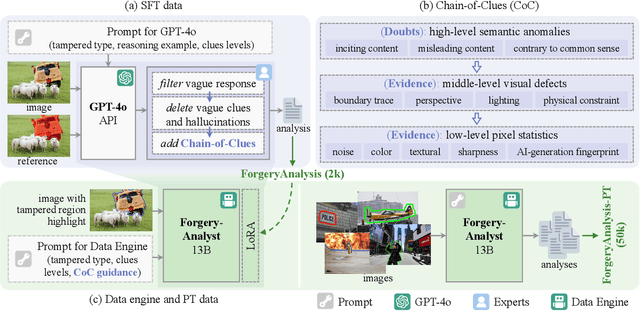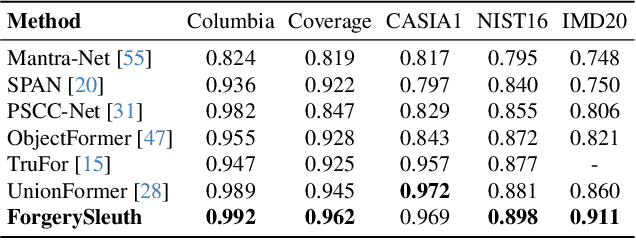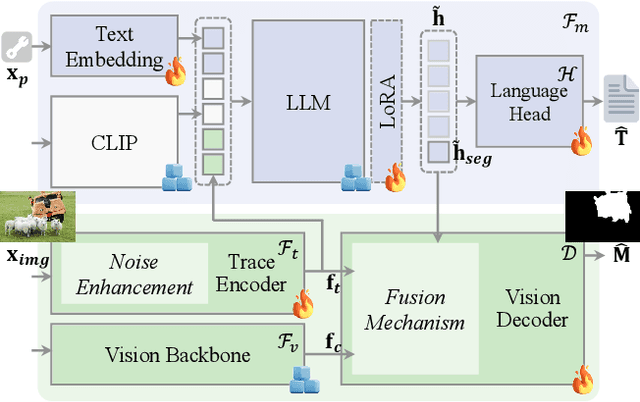Haoran Chen
PupiNet: Seamless OCT-OCTA Interconversion Through Wavelet-Driven and Multi-Scale Attention Mechanisms
Mar 31, 2025Abstract:Optical Coherence Tomography (OCT) and Optical Coherence Tomography Angiography (OCTA) are key diagnostic tools for clinical evaluation and management of retinal diseases. Compared to traditional OCT, OCTA provides richer microvascular information, but its acquisition requires specialized sensors and high-cost equipment, creating significant challenges for the clinical deployment of hardware-dependent OCTA imaging methods. Given the technical complexity of OCTA image acquisition and potential mechanical artifacts, this study proposes a bidirectional image conversion framework called PupiNet, which accurately achieves bidirectional transformation between 3D OCT and 3D OCTA. The generator module of this framework innovatively integrates wavelet transformation and multi-scale attention mechanisms, significantly enhancing image conversion quality. Meanwhile, an Adaptive Discriminator Augmentation (ADA) module has been incorporated into the discriminator to optimize model training stability and convergence efficiency. To ensure clinical accuracy of vascular structures in the converted images, we designed a Vessel Structure Matcher (VSM) supervision module, achieving precise matching of vascular morphology between generated images and target images. Additionally, the Hierarchical Feature Calibration (HFC) module further guarantees high consistency of texture details between generated images and target images across different depth levels. To rigorously validate the clinical effectiveness of the proposed method, we conducted a comprehensive evaluation on a paired OCT-OCTA image dataset containing 300 eyes with various retinal pathologies. Experimental results demonstrate that PupiNet not only reliably achieves high-quality bidirectional transformation between the two modalities but also shows significant advantages in image fidelity, vessel structure preservation, and clinical usability.
EDEN: Enhanced Diffusion for High-quality Large-motion Video Frame Interpolation
Mar 20, 2025Abstract:Handling complex or nonlinear motion patterns has long posed challenges for video frame interpolation. Although recent advances in diffusion-based methods offer improvements over traditional optical flow-based approaches, they still struggle to generate sharp, temporally consistent frames in scenarios with large motion. To address this limitation, we introduce EDEN, an Enhanced Diffusion for high-quality large-motion vidEo frame iNterpolation. Our approach first utilizes a transformer-based tokenizer to produce refined latent representations of the intermediate frames for diffusion models. We then enhance the diffusion transformer with temporal attention across the process and incorporate a start-end frame difference embedding to guide the generation of dynamic motion. Extensive experiments demonstrate that EDEN achieves state-of-the-art results across popular benchmarks, including nearly a 10% LPIPS reduction on DAVIS and SNU-FILM, and an 8% improvement on DAIN-HD.
4D-ACFNet: A 4D Attention Mechanism-Based Prognostic Framework for Colorectal Cancer Liver Metastasis Integrating Multimodal Spatiotemporal Features
Mar 12, 2025Abstract:Postoperative prognostic prediction for colorectal cancer liver metastasis (CRLM) remains challenging due to tumor heterogeneity, dynamic evolution of the hepatic microenvironment, and insufficient multimodal data fusion. To address these issues, we propose 4D-ACFNet, the first framework that synergistically integrates lightweight spatiotemporal modeling, cross-modal dynamic calibration, and personalized temporal prediction within a unified architecture. Specifically, it incorporates a novel 4D spatiotemporal attention mechanism, which employs spatiotemporal separable convolution (reducing parameter count by 41%) and virtual timestamp encoding to model the interannual evolution patterns of postoperative dynamic processes, such as liver regeneration and steatosis. For cross-modal feature alignment, Transformer layers are integrated to jointly optimize modality alignment loss and disentanglement loss, effectively suppressing scale mismatch and redundant interference in clinical-imaging data. Additionally, we design a dynamic prognostic decision module that generates personalized interannual recurrence risk heatmaps through temporal upsampling and a gated classification head, overcoming the limitations of traditional methods in temporal dynamic modeling and cross-modal alignment. Experiments on 197 CRLM patients demonstrate that the model achieves 100% temporal adjacency accuracy (TAA), with performance significantly surpassing existing approaches. This study establishes the first spatiotemporal modeling paradigm for postoperative dynamic monitoring of CRLM. The proposed framework can be extended to prognostic analysis of multi-cancer metastases, advancing precision surgery from "spatial resection" to "spatiotemporal cure."
Achieving More with Less: Additive Prompt Tuning for Rehearsal-Free Class-Incremental Learning
Mar 11, 2025Abstract:Class-incremental learning (CIL) enables models to learn new classes progressively while preserving knowledge of previously learned ones. Recent advances in this field have shifted towards parameter-efficient fine-tuning techniques, with many approaches building upon the framework that maintains a pool of learnable prompts. Although effective, these methods introduce substantial computational overhead, primarily due to prompt pool querying and increased input sequence lengths from prompt concatenation. In this work, we present a novel prompt-based approach that addresses this limitation. Our method trains a single set of shared prompts across all tasks and, rather than concatenating prompts to the input, directly modifies the CLS token's attention computation by adding the prompts to it. This simple and lightweight design not only significantly reduces computational complexity-both in terms of inference costs and the number of trainable parameters-but also eliminates the need to optimize prompt lengths for different downstream tasks, offering a more efficient yet powerful solution for rehearsal-free class-incremental learning. Extensive experiments across a diverse range of CIL benchmarks demonstrate the effectiveness of our approach, highlighting its potential to establish a new prompt-based CIL paradigm. Furthermore, experiments on general recognition benchmarks beyond the CIL setting also show strong performance, positioning our method as a promising candidate for a general parameter-efficient fine-tuning approach.
Multi-Layer Visual Feature Fusion in Multimodal LLMs: Methods, Analysis, and Best Practices
Mar 08, 2025Abstract:Multimodal Large Language Models (MLLMs) have made significant advancements in recent years, with visual features playing an increasingly critical role in enhancing model performance. However, the integration of multi-layer visual features in MLLMs remains underexplored, particularly with regard to optimal layer selection and fusion strategies. Existing methods often rely on arbitrary design choices, leading to suboptimal outcomes. In this paper, we systematically investigate two core aspects of multi-layer visual feature fusion: (1) selecting the most effective visual layers and (2) identifying the best fusion approach with the language model. Our experiments reveal that while combining visual features from multiple stages improves generalization, incorporating additional features from the same stage typically leads to diminished performance. Furthermore, we find that direct fusion of multi-layer visual features at the input stage consistently yields superior and more stable performance across various configurations. We make all our code publicly available: https://github.com/EIT-NLP/Layer_Select_Fuse_for_MLLM.
DynSegNet:Dynamic Architecture Adjustment for Adversarial Learning in Segmenting Hemorrhagic Lesions from Fundus Images
Feb 13, 2025Abstract:The hemorrhagic lesion segmentation plays a critical role in ophthalmic diagnosis, directly influencing early disease detection, treatment planning, and therapeutic efficacy evaluation. However, the task faces significant challenges due to lesion morphological variability, indistinct boundaries, and low contrast with background tissues. To improve diagnostic accuracy and treatment outcomes, developing advanced segmentation techniques remains imperative. This paper proposes an adversarial learning-based dynamic architecture adjustment approach that integrates hierarchical U-shaped encoder-decoder, residual blocks, attention mechanisms, and ASPP modules. By dynamically optimizing feature fusion, our method enhances segmentation performance. Experimental results demonstrate a Dice coefficient of 0.6802, IoU of 0.5602, Recall of 0.766, Precision of 0.6525, and Accuracy of 0.9955, effectively addressing the challenges in fundus image hemorrhage segmentation.[* Corresponding author.]
A Benchmark for Crime Surveillance Video Analysis with Large Models
Feb 13, 2025Abstract:Anomaly analysis in surveillance videos is a crucial topic in computer vision. In recent years, multimodal large language models (MLLMs) have outperformed task-specific models in various domains. Although MLLMs are particularly versatile, their abilities to understand anomalous concepts and details are insufficiently studied because of the outdated benchmarks of this field not providing MLLM-style QAs and efficient algorithms to assess the model's open-ended text responses. To fill this gap, we propose a benchmark for crime surveillance video analysis with large models denoted as UCVL, including 1,829 videos and reorganized annotations from the UCF-Crime and UCF-Crime Annotation datasets. We design six types of questions and generate diverse QA pairs. Then we develop detailed instructions and use OpenAI's GPT-4o for accurate assessment. We benchmark eight prevailing MLLMs ranging from 0.5B to 40B parameters, and the results demonstrate the reliability of this bench. Moreover, we finetune LLaVA-OneVision on UCVL's training set. The improvement validates our data's high quality for video anomaly analysis.
SymbioSim: Human-in-the-loop Simulation Platform for Bidirectional Continuing Learning in Human-Robot Interaction
Feb 11, 2025Abstract:The development of intelligent robots seeks to seamlessly integrate them into the human world, providing assistance and companionship in daily life and work, with the ultimate goal of achieving human-robot symbiosis. To realize this vision, robots must continuously learn and evolve through consistent interaction and collaboration with humans, while humans need to gradually develop an understanding of and trust in robots through shared experiences. However, training and testing algorithms directly on physical robots involve substantial costs and safety risks. Moreover, current robotic simulators fail to support real human participation, limiting their ability to provide authentic interaction experiences and gather valuable human feedback. In this paper, we introduce SymbioSim, a novel human-in-the-loop robotic simulation platform designed to enable the safe and efficient development, evaluation, and optimization of human-robot interactions. By leveraging a carefully designed system architecture and modules, SymbioSim delivers a natural and realistic interaction experience, facilitating bidirectional continuous learning and adaptation for both humans and robots. Extensive experiments and user studies demonstrate the platform's promising performance and highlight its potential to significantly advance research on human-robot symbiosis.
Whole-Body Integrated Motion Planning for Aerial Manipulators
Jan 11, 2025Abstract:Efficient motion planning for Aerial Manipulators (AMs) is essential for tackling complex manipulation tasks, yet achieving coupled trajectory planning remains challenging. In this work, we propose, to the best of our knowledge, the first whole-body integrated motion planning framework for aerial manipulators, which is facilitated by an improved Safe Flight Corridor (SFC) generation strategy and high-dimensional collision-free trajectory planning. In particular, we formulate an optimization problem to generate feasible trajectories for both the quadrotor and manipulator while ensuring collision avoidance, dynamic feasibility, kinematic feasibility, and waypoint constraints. To achieve collision avoidance, we introduce a variable geometry approximation method, which dynamically models the changing collision volume induced by different manipulator configurations. Moreover, waypoint constraints in our framework are defined in $\mathrm{SE(3)\times\mathbb{R}^3}$, allowing the aerial manipulator to traverse specified positions while maintaining desired attitudes and end-effector states. The effectiveness of our framework is validated through comprehensive simulations and real-world experiments across various environments.
ForgerySleuth: Empowering Multimodal Large Language Models for Image Manipulation Detection
Nov 29, 2024



Abstract:Multimodal large language models have unlocked new possibilities for various multimodal tasks. However, their potential in image manipulation detection remains unexplored. When directly applied to the IMD task, M-LLMs often produce reasoning texts that suffer from hallucinations and overthinking. To address this, in this work, we propose ForgerySleuth, which leverages M-LLMs to perform comprehensive clue fusion and generate segmentation outputs indicating specific regions that are tampered with. Moreover, we construct the ForgeryAnalysis dataset through the Chain-of-Clues prompt, which includes analysis and reasoning text to upgrade the image manipulation detection task. A data engine is also introduced to build a larger-scale dataset for the pre-training phase. Our extensive experiments demonstrate the effectiveness of ForgeryAnalysis and show that ForgerySleuth significantly outperforms existing methods in generalization, robustness, and explainability.
 Add to Chrome
Add to Chrome Add to Firefox
Add to Firefox Add to Edge
Add to Edge